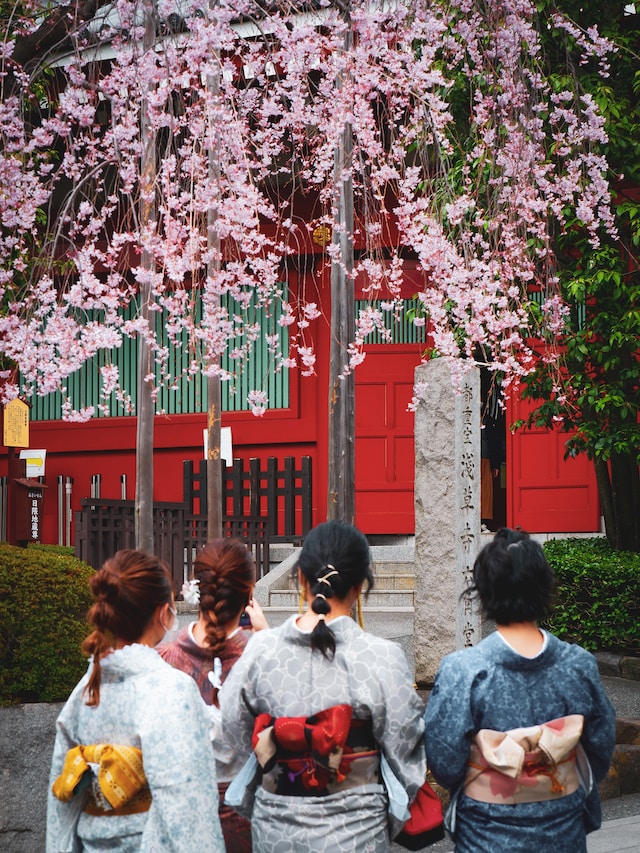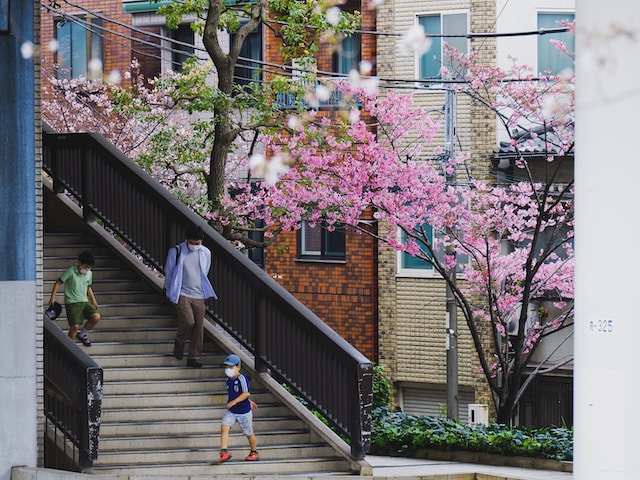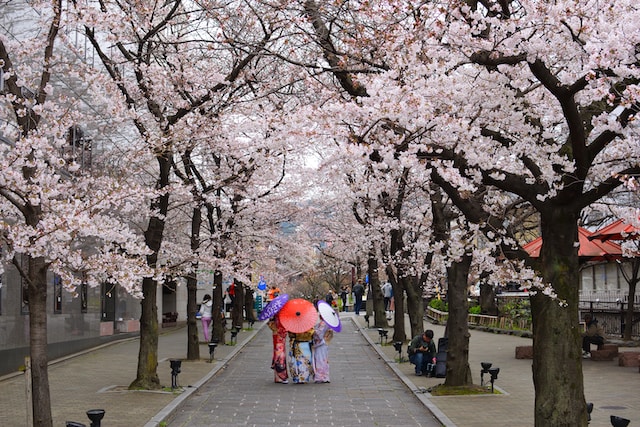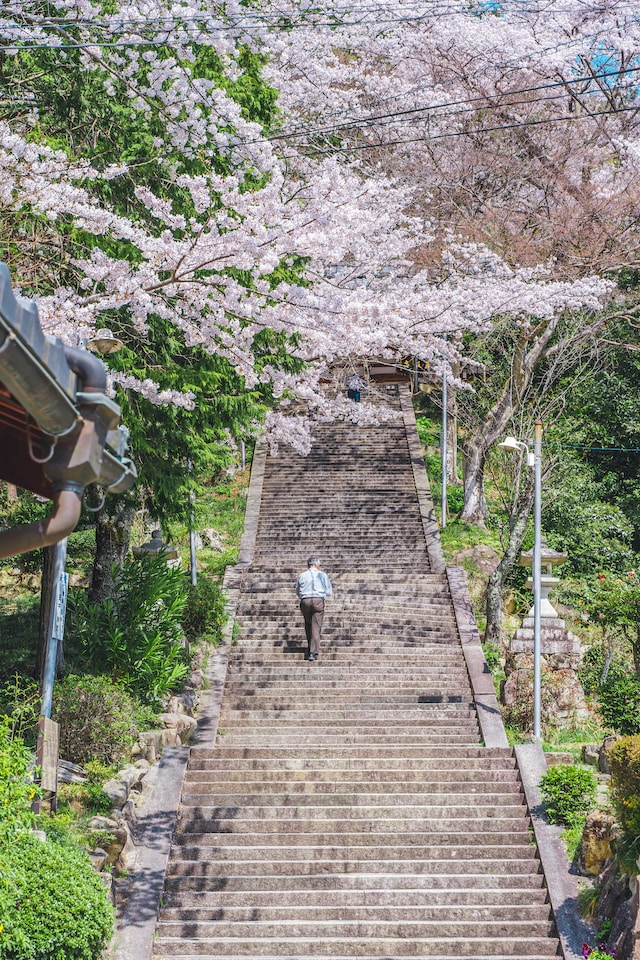
In the springtime, the world comes alive with a burst of new colors and fragrances. None more beautiful, perhaps, than the pink and white petals of the cherry blossom tree. For centuries, these flowers have been revered in Japan, where they symbolize the transience of life and the beauty of impermanence.
In recent years, however, cherry blossom festivals have spread around the globe, as people from all cultures come together to celebrate the wonder of nature’s rebirth.From Washington D.C. to Vancouver to Tokyo, millions of visitors flock to these events each year, eager to witness the splendor of thousands of cherry trees blooming at once.
One of the most iconic sights at these festivals is the traditional Japanese art of hanami, or flower viewing. Families and friends gather beneath the flowering branches to eat, drink, and celebrate the season. They bring picnic blankets, bento boxes filled with sushi and other treats, and often share sake, cherry blossom sake or tea. For some, it’s a time of quiet reflection and introspection, while others revel in the joyous atmosphere of the crowds.
But cherry blossom festivals are more than just a celebration of beauty. They also play an important role in fostering cultural exchange and understanding. Through performances of traditional music and dance, exhibitions of Japanese art and crafts, and other educational activities, visitors can gain a deeper appreciation for the history and culture of Japan. Likewise, Japanese visitors are able to connect with people from other countries and share their own unique perspectives.
Symbolism of Cherry Blossoms
At its core, the cherry blossom festival is a celebration of life itself — a reminder that, like the petals of the cherry blossom, our lives are fleeting, but also beautiful and full of meaning. As the world slowly emerges from the darkness of the pandemic, there’s perhaps no better time to pause and appreciate the wonders of the world around us.
The delicate cherry blossom holds deep meaning and symbolism in various cultures, particularly in Japan. These beautiful flowers represent more than just nature’s ephemeral beauty. Here, we explore the rich symbolism behind cherry blossoms and delve into their significance in different aspects of life.
- Transience and Impermanence
The fleeting nature of cherry blossoms is a reminder of the transient and impermanent nature of life itself. Their short bloom period symbolizes the ephemeral and fragile beauty of existence. This perspective is see as an encouragement to appreciate life’s fleeting moments and a reminder to seize the opportunities before us.
- Renewal and Rebirth
Cherry blossoms are associated with the arrival of spring, a season of renewal and rebirth. Their blossoming signifies the end of winter and the beginning of a new cycle of life. Through their vibrant blooms, cherry blossoms inspire hope and optimism, reminding us that after the darkest of times, there is always a chance for new beginnings.
- Beauty in Simplicity
The simplicity of cherry blossoms’ delicate petals commands attention and admiration. This simplicity serves as a reminder to find beauty in the simplest of things, appreciating the elegance of nature’s designs. It’s an encouragement to embrace minimalism and recognize that true beauty often lies in the absence of complexity.
- Cultural Significance
In Japan, cherry blossoms hold immense cultural importance and are deeply intertwined with the country’s identity. They symbolize the samurai’s code of Bushido, representing the fleeting nature of life in the face of honor and duty. Cherry blossoms have also been associated with the concept of mono no aware, a Japanese aesthetic principle centered around the appreciation of the impermanence of things.

- Love and Romanticism
Cherry blossoms exude an air of enchantment and romance, capturing the hearts of many. In Japanese culture, the delicate flowers symbolize love, affection, and the beauty of fleeting relationships. They often serve as a visual backdrop for couples during romantic encounters, picnics, and weddings.
Timing and Forecasting of Cherry Blossom Festivals
When it comes to cherry blossom festivals, timing is everything. The peak bloom period, when cherry trees are adorned with a lush display of blossoms, varies from year to year and is highly dependent on weather conditions. To ensure visitors don’t miss out on the spectacle, there are several key factors to consider in timing and forecasting these magnificent events.
- Weather Conditions: The timing of cherry blossoms is closely tied to the weather patterns leading up to spring. Warmer temperatures in the weeks preceding bloom can accelerate the process, while cooler temperatures may delay it. Factors such as sunlight, rainfall, and wind can also affect the progression and longevity of the blooms.
Historical Data: To forecast the timing of cherry blossoms, festival organizers often rely on historical data. Over the years, patterns and trends emerge, allowing for fairly accurate predictions. This valuable information assists both locals and tourists in planning their visits to coincide with the peak bloom period.

- Blossom Forecasting Organizations: In Japan, there are several official organizations dedicated to providing cherry blossom forecasts. These organizations closely monitor weather patterns and track the progression of cherry blossoms across the country. They publish regular reports, updating the public on the expected blooming dates in various regions, ensuring visitors have the most up-to-date information.
- Cherry Blossom Maps: Cherry blossom maps have become invaluable tools for festival-goers. These interactive and user-friendly online maps provide real-time updates on the blooming stages of cherry trees. They include detailed information about specific locations, allowing visitors to plan their itineraries accordingly. With just a few clicks, travelers can explore the most vibrant cherry blossom spots and witness the breathtaking beauty at its peak.
- Flexibility and Patience: Despite careful forecasting and planning, nature has its way of surprising us. The exact timing of cherry blossoms can be unpredictable, as they are subject to the whims of Mother Nature. Therefore, a flexible and patient mindset is essential for those hoping to experience the magic of cherry blossom festivals. By allowing for some flexibility in travel dates and embracing the unexpected, visitors can fully appreciate the wonder of nature’s timing and the joy it brings.
Hanami Culture
Hanami, meaning “flower viewing” in Japanese, is a cherished cultural tradition that accompanies cherry blossom festivals. It is a time-honored practice that brings people together to appreciate the ephemeral beauty of the cherry blossoms in full bloom. Here, we delve into the essence of hanami culture and the rituals that make this tradition so special.
The tradition dates back to ancient times in Japan, where it was initially practiced by the elite, including members of the imperial court and samurai warriors. It gradually spread to the general public, becoming a popular cultural activity celebrated by people from all walks of life. Hanami is deeply rooted in the concept of mono no aware, which embraces the transient nature of life and the bittersweet beauty of passing moments.
Finding the Perfect Spot: Planning for Hanami
Locals and visitors alike carefully plan their hanami experience by selecting the ideal location to view the cherry blossoms. Parks, gardens, and riverbanks are popular venues, offering picturesque settings with clusters of cherry trees in full bloom. Many cities have designated hanami spots that are known for their vibrant displays of cherry blossoms, attracting large crowds during the festivals.

Hanami Picnics: Sharing Food and Joy
Central to hanami culture is the tradition of enjoying a picnic beneath the cherry blossom trees. Families, friends, and coworkers gather together to share in the festivities. Traditional Japanese bento boxes, filled with an assortment of delectable treats, are packed for the occasion. Participants bring blankets, cushions, or tarpaulins to create a comfortable space beneath the trees, creating a cozy and communal atmosphere.
Sake, Tea, and Celebration: Toasting to the Blossoms
Sake, a traditional Japanese rice wine, and tea play an integral role in hanami celebrations. Participants often bring bottles of cherry blossom sake, a seasonal specialty, to enhance the experience and make toasts to the beauty of the blossoms. Traditional tea ceremonies are also held, where guests can savor the delicate flavors of matcha while immersing themselves in the tranquility of the surroundings.
Traditional Arts and Performances: Adding Cultural Flair
Hanami festivals are not only about admiring nature’s beauty; they also showcase a variety of traditional arts and performances. Traditional Japanese music, such as the enchanting melodies of the koto or the soothing sounds of the shakuhachi flute, fills the air. Dance performances, featuring elegant movements and vibrant costumes, transport spectators to a world of grace and enchantment.
Hanami at Night: Illuminating the Beauty
In some places, hanami extends into the evening as the cherry blossoms are illuminated, casting a magical glow. Nighttime hanami gatherings create a different ambiance, where the blossoms take on a dreamlike quality against the dark sky. Lanterns and decorative lighting enhance the ethereal atmosphere, creating a sense of enchantment and romance.
Capturing the Moment: Photography and Artistry
Hanami has inspired countless photographers and artists to capture the beauty of cherry blossoms in various forms of art. From traditional paintings and calligraphy to modern photography, capturing the essence of hanami has become an art form in itself. Visitors often join in the creative expression, capturing their own personal memories of hanami through photographs and sketches.
Cherry blossom festivals are more than just a feast for the eyes. They represent the beauty and fragility of life, the renewal and hope of spring, and a celebration of cultural exchange and understanding. Whether you’re sitting beneath the blossoming branches, enjoying a picnic with loved ones, or immersing yourself in the traditional arts and performances, these festivals offer a moment of tranquility and reflection. As we navigate the complexities of the world, let us not forget to pause and appreciate the wonders of nature and the fleeting moments that make life truly beautiful.

